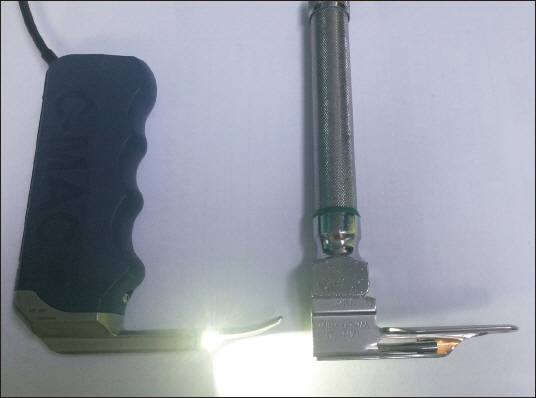Anesth Pain Med.
2017 Oct;12(4):339-341. 10.17085/apm.2017.12.4.339.
Successful use of C-MAC® video laryngoscope following failure of multiple intubation attempts during laryngomicroscopic surgery in an infant: A case report
- Affiliations
-
- 1Department of Anesthesiology and Pain Medicine, Dankook University College of Medicine, Cheonan, Korea.
- 2Department of Anesthesiology and Pain Medicine, Kyung Hee University Hospital at Gangdong, Kyung Hee University College of Medicine, Seoul, Korea. seohyungseok@gmail.com
- KMID: 2405851
- DOI: http://doi.org/10.17085/apm.2017.12.4.339
Abstract
- A 6-month-old boy was scheduled for a laryngeal mass excision and tracheal bougienage for secondary subglottic stenosis. Following successful excision of the laryngeal mass, a tracheal tube was temporarily extubated for tracheal bougination. However, tracheal re-intubation using a direct laryngoscope with the Miller blade failed because of mucosal swelling and bloody secretions. Following multiple intubation attempts, the patient's peripheral oxygen saturation had decreased to 52%. Immediately, a video laryngoscope was requested, and, by using the C-MAC® video laryngoscope, the patient was successfully re-intubated. Because pediatric patients are more vulnerable to desaturation, extreme caution should be used in securing airways even during a short apneic period. Using a video laryngoscope at the first intubation attempt would be useful for successful tracheal intubation.
Keyword
Figure
Reference
-
1. Sakles JC, Mosier J, Chiu S, Cosentino M, Kalin L. A comparison of the C-MAC video laryngoscope to the Macintosh direct laryngoscope for intubation in the emergency department. Ann Emerg Med. 2012; 60:739–48. DOI: 10.1016/j.annemergmed.2012.06.150. PMID: 22560464. PMCID: PMC4532403.2. Harless J, Ramaiah R, Bhananker SM. Pediatric airway management. Int J Crit Illn Inj Sci. 2014; 4:65–70. DOI: 10.4103/2229-5151.128015. PMID: 24741500. PMCID: PMC3982373.3. Vlatten A, Aucoin S, Litz S, Macmanus B, Soder C. A comparison of the STORZ video laryngoscope and standard direct laryngoscopy for intubation in the Pediatric airway--a randomized clinical trial. Paediatr Anaesth. 2009; 19:1102–7. DOI: 10.1111/j.1460-9592.2009.03127.x. PMID: 19708910.4. Choi GS, Lee EH, Lim CS, Yoon SH. A comparative study on the usefulness of the Glidescope or Macintosh laryngoscope when intubating normal airways. Korean J Anesthesiol. 2011; 60:339–43. DOI: 10.4097/kjae.2011.60.5.339. PMID: 21716906. PMCID: PMC3110292.5. Nagler J, Bachur RG. Advanced airway management. Curr Opin Pediatr. 2009; 21:299–305. DOI: 10.1097/MOP.0b013e32832b112c. PMID: 19387345.6. Piepho T, Fortmueller K, Heid FM, Schmidtmann I, Werner C, Noppens RR. Performance of the C-MAC video laryngoscope in patients after a limited glottic view using Macintosh laryngoscopy. Anaesthesia. 2011; 66:1101–5. DOI: 10.1111/j.1365-2044.2011.06872.x. PMID: 21883131.7. Serocki G, Neumann T, Scharf E, Dörges V, Cavus E. Indirect videolaryngoscopy with C-MAC D-Blade and GlideScope:a randomized, controlled comparison in patients with suspected difficult airways. Minerva Anestesiol. 2013; 79:121–9. PMID: 23032922.8. Kilicaslan A, Topal A, Tavlan A, Erol A, Otelcioglu S. Effectiveness of the C-MAC video laryngoscope in the management of unexpected failed intubations. Braz J Anesthesiol. 2014; 64:62–5. DOI: 10.1016/j.bjan.2013.03.001. PMID: 24565390.9. Singh R, Kumar N, Jain A. A randomized trial to compare the Truview picture capture device, C-MAC laryngoscope, and Macintosh laryngoscope in pediatric airway management. Acta Anaesthesiol Taiwan 2015 [Epub ahead of print]. DOI: 10.1016/j.aat.2015.01.001.10. Healy DW, Picton P, Morris M, Turner C. Comparison of the glidescope, CMAC, storz DCI with the Macintosh laryngoscope during simulated difficult laryngoscopy:a manikin study. BMC Anesthesiol. 2012; 12:11. DOI: 10.1186/1471-2253-12-11. PMID: 22720884. PMCID: PMC3519500.11. Mausser G, Friedrich G, Schwarz G. Airway management and anesthesia in neonates, infants and children during endolaryngotracheal surgery. Paediatr Anaesth. 2007; 17:942–7. DOI: 10.1111/j.1460-9592.2007.02300.x. PMID: 17767629.12. Davies R, Balachandran S. Anterior commissure laryngoscope. Anaesthesia. 2003; 58:721–2. DOI: 10.1046/j.1365-2044.2003.327713.x. PMID: 12790830.13. Black AE, Flynn PE, Smith HL, Thomas ML, Wilkinson KA. Development of a guideline for the management of the unanticipated difficult airway in pediatric practice. Paediatr Anaesth. 2015; 25:346–62. DOI: 10.1111/pan.12615. PMID: 25684039.
- Full Text Links
- Actions
-
Cited
- CITED
-
- Close
- Share
- Similar articles
-
- Comparison of the Macintosh Laryngoscope and the GlideScope(R) Video Laryngoscope in Easy and Simulated Difficult Airway Scenarios: A Manikin Study
- Successful airway management with combined use of McGrath® MAC video laryngoscope and fiberoptic bronchoscope in a severe obese patient with huge goiter: a case report
- Educational suitability of endotracheal intubation using a video-laryngoscope
- A Case of Successful Use of C-MAC® Video Laryngoscope in ‘Cannot Ventilate’ Situation Due to Unexpected Severe Narrowing of Laryngeal Inlet
- Successful intubation using video laryngoscope in a child with CHARGE syndrome: A case report


